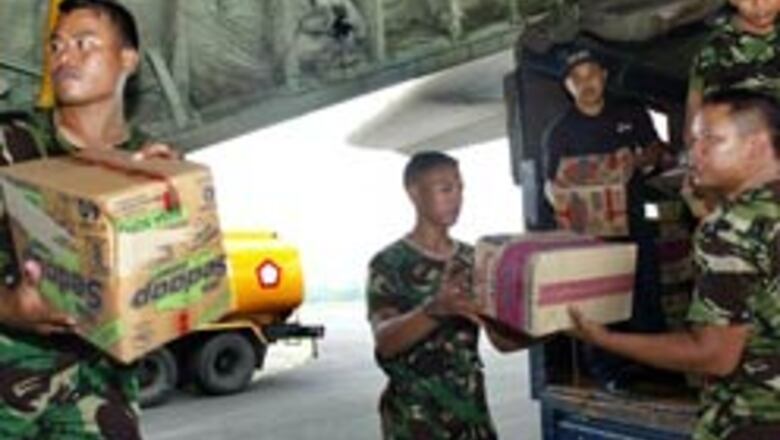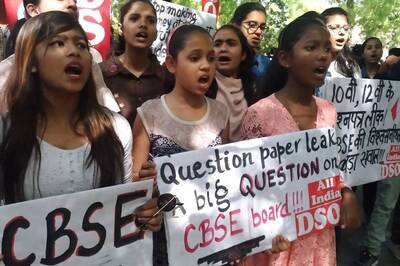
views
Bantul (Indonesia): Emergency aid began arriving on Monday in areas devastated by a 6.3-magnitude earthquake in Indonesia.
The officials however, said that the supplies were not reaching survivors quickly enough as victims pleaded for money on debris-filled roads to buy food.
An aid plane chartered by the UN's children agency arrived in the city of Solo, about three hours from the hardest-hit district of Bantul on Java island.
It was loaded with water, tents, stoves and cooking sets that officials said would be distributed later on Monday.
On Sunday, three UN trucks brought high-energy biscuits to survivors and two Singapore military cargo planes arrived at Yogyakarta airport with doctors and medical supplies.
However, officials said that relief supplies remained inadequate.
"We have received food and medicine from the government but it's not enough," said Suparno, a neighborhood official in Bantul who goes by one name, like many Indonesians.
"How can I distribute 40 kilograms (88 pounds) of rice to 1,200 people?" he added.
Hundreds of villagers lined main roads in the disaster zone, holding out donation boxes. They explained that any money collected would be used communally to buy rice, oil and candles.
"We need help. Anything at all," one sign read.
President Susilo Bambang Yudhoyono acknowledged a "lack of coordination" in aid distribution when he visited refugees on Monday and called for government officials to be "more agile."
"I saw in many areas that there are many things that need to be speeded up," he said.
Yudhoyono, who is criticised by some as being hesitant to act in the past, spent the first night after Saturday's quake sleeping in a tent along with survivors and moved his office to the nearby city of Yogyakarta to supervise relief operations.
The government said that the quake killed more than 4,300 and left an estimated 200,000 people homeless, most of whom are now living in shacks close to their former homes or in shelters erected in rice fields. Hospitals overflowed with bloodied survivors.
The area affected by the quake stretches across hundreds of square miles of mostly farming communities to the south of the ancient city of Yogyakarta.
The quake has intensified activity at the nearby Mount Merapi volcano, which spit out lava and hot clouds Monday, sending debris avalanching 2½ miles down the mountain, said Subandriyo, chief of the Merapi volcanology and monitoring office.
No one was injured because the debris tumbled down unpopulated sections of the peak.
PAGE_BREAK
Countries across Asia and the world have pledged millions of dollars, tons of supplies and hundreds of personnel and Indonesia said that it would allocate $107 million to help rebuild over the next year on late Sunday.
The US military plans to send 100 doctors, nurses and medical technicians from a base in Okinawa to Indonesia to treat everything from trauma and broken bones to lesser injuries like bruises, US Pacific Command spokesman Lt Col Bill Bigelow said on Sunday.
The United States has allocated $2.5 million for assistance to victims.
Some villagers had received clothing and food, but most were still fending for themselves more than 48 hours after the quake struck.
"All our valuables are gone," said Hardadi, as she cooked breakfast for three families living under a shelter made from fertilizer sacks.
"But at least we managed to get the children out alive," she added.
Many survivors worked together to clear the rubble and salvage building materials to build temporary shelters and health centers.
One woman was collecting pieces of broken glass from a path, a hazard given that so many survivors are without shoes.
"The people here have the spirit to rebuild their lives," said Prapto Warsito, a village chief. "They have a long tradition of working and living together," he added.
In one village, women brought their children to a well inside a damaged house, and threw buckets of water over them as they stood on pieces of a broken table.
"All we need now is a comb," joked one woman, who appeared in good spirits despite losing her father and home to the quake.
Electricity and water supplies were still down in much of the region on Monday. Torrential rains have fallen at least twice since the disaster, adding to the misery of survivors.
The quake was the fourth destructive temblor to hit Indonesia in the last 17 months, including the one that spawned the Dec 26, 2004, tsunami that killed 230,000 people across Asia, most of them on this Indian Ocean archipelago.
The country also is battling the bird flu crisis, a spate of terror attacks by al-Qaida-linked Islamic militants and the threat of eruption from Mount Merapi, just north of the quake zone.
Indonesia, the world's largest archipelago, is prone to seismic upheaval due to its location on the so-called Pacific ‘Ring of Fire’, an arc of volcanoes and fault lines encircling the Pacific Basin. It has 76 volcanoes, the largest number in the world.


















Comments
0 comment